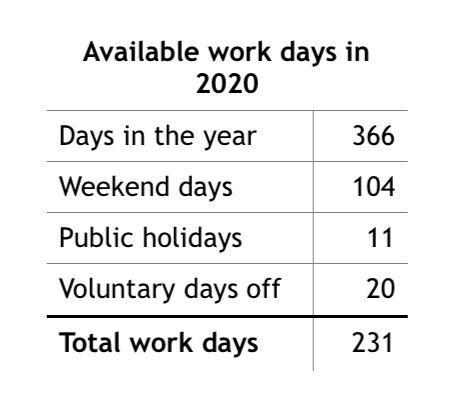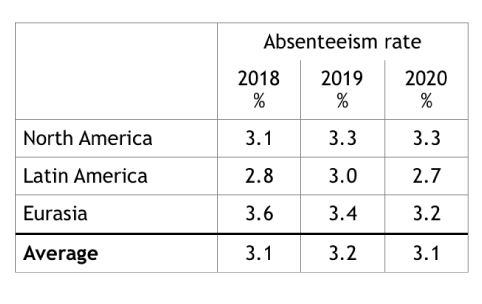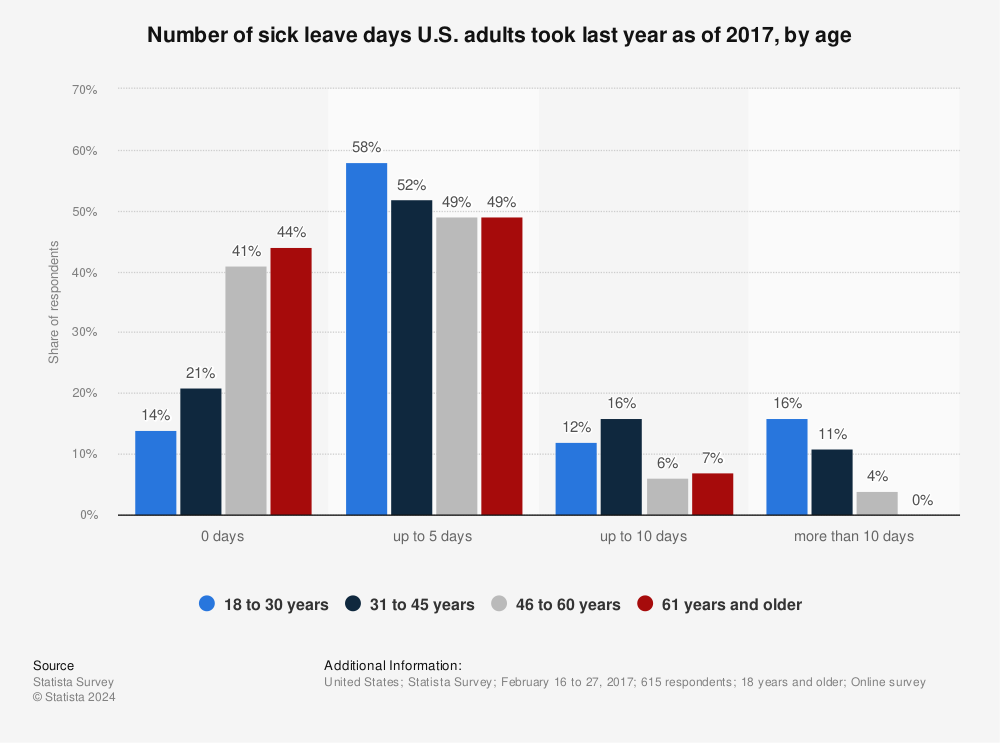Absenteeism Rate Explained | Formula & Meaning of Absence Rate

The absenteeism rate is a key measure of organizational health and well-being. Whether you measure it for the entire organization or an individual, knowing the exact absence rate will help shape interventions. In this article, we will explain the absence rate, how to calculate this rate according to ISO norms, and give some benchmarks on what a healthy and a high absenteeism rate looks like.
Contents
What is an absenteeism rate?
How to calculate an absenteeism rate?
Absenteeism rate example
Absenteeism rate reporting
Absence rate vs. absence frequency
What is a high absenteeism rate?
6 tips to lower the absence rate
What is an absenteeism rate?
The absenteeism rate, absence rate, or absence percentage, is the rate of unplanned absence due to sickness or other causes. The absenteeism rate can be measured for an individual, team, or the organization as a whole. Each number gives information about the vitality of the organization.
To understand the absence rate, we need to understand absence. Absence in the workplace is an occasion or period of being away from work. Absence in the workplace is caused by physical illness, stress-related illness or the occasional sickie – a fake sick day, or absence due to other reasons. This can include a mother calling in sick herself so she can take care of her sick son or daughter. Holidays and lateness are not included in the absence rate.
Just like employee turnover, absenteeism is a negative job behavior. While some absenteeism is normal for an organization, high levels of absence can indicate problems in the organization.
How to calculate an absenteeism rate?
To calculate an absenteeism rate, you need employee absence data. This absence data should at least contain the number of days an individual or group or individuals were absent and the dates associated with that absence. You will also need the number of available workdays in a given period.
According to the International Organization for Standardization (ISO), the absenteeism rate is measured as follows:
This absenteeism rate can be used for any time period.
Let’s go over each part of the absenteeism formula. First, we need the number of absent days. These are the number of days that an employee was 100% absent. These can usually be found in the company’s Human Resources Information System, software that usually includes an absence tally.
Second, we need the number of available workdays in a given period. This varies per country and year, as official holidays don’t count towards the absenteeism rate. After all, you can’t be absent from work if you weren’t working in the first place
The annual absenteeism rate formula is very similar.
To calculate the number of available workdays, take the number of days in the year, minus weekend days, public holidays, public holidays (including mandatory company days) and voluntary days off (vacation days and special days). In the example below, we do this for 2020 – a leap year.

A great online tool to calculate this is Workingdays. In this tool, you can specify your country and the data range. They also offer an API that can be integrated into your HR reporting software to automatically request the number of working days in a given period for a given country.
Absenteeism rate example
Let’s look at an example of how the absenteeism rate formula works.
Someone – let’s call her Wendy – worked full-time in the US in 2020. She was absent for 10 days during that year. In line with the example above, she has 20 vacation days, so her total workdays are 231. This means that Wendy’s absenteeism rate would be:
Similarly, this formula can be used for groups as well.
Absenteeism rate reporting
Absenteeism rates are often reported by different teams, departments, or geographies. This is a helpful way of identifying pockets of high absence in the organization, which can lead to effective and targeted interventions.
An example report could look as follows:
Other absenteeism metrics often included in absence reporting are the absence reporting frequency, average absence duration in days, zero absence rate, number of absence instances, and number of absence endings. An example of a 2019 absence report is shown below.
Other metrics include the total number of absence days and absence cost.
Absence rate vs. absence frequency
One of the metrics included in the report above is the absence reporting frequency, also called absence frequency. The difference between the absence rate and absence frequency is that the absence rate indicates severity, while the absence frequency is about the absence pattern.
For example, with a 4% absence, you can be ill for 10 days in a row when you catch a case of bronchitis, or you can be ill 10 times, for one day each. In this case, it is unlikely that you’re severely ill. You will be more likely to be stressed or in some physical pain, as a day off may relieve the discomfort sufficiently for you to get back to work the next day.
Similarly, imagine two departments with both high absence rates. One department has a low absence frequency while the other has a high frequency. What does this mean? The department with the low frequency had fewer people ill for a long time (e.g., someone has a burnout while the rest is fine) while the other department has many shorter instances of absence. These patters can give clues for effective interventions.
Absence rate and absence frequency also have interesting patterns over time. Research shows that as people age, avoidable absence goes down, especially for men. This could be because older employees take their work more seriously.
A meta-analysis by Ng and Feldman (2008) with a sample size of over 70,000 found that age was negatively related to general absences (r = .26) and non-sickness-related absence (r = .10), but positively related to sickness absence, albeit very weakly (r = .02). This is also reflected in the graph below that displays sick leave days among adults by age in the US.
So technically, older employees are more often ill compared to younger ones. However, research shows that they are much less likely to be absent in general.
Interestingly, the employee absenteeism rate within an organization is relatively stable. Research by Breaugh (1981) showed that the past absenteeism rate was a better predictor of next year’s absence rate than 3 work attitudes that predicted absenteeism.
What is a high absenteeism rate?
To determine whether an absence rate is high, we first need to look at what a normal absenteeism rate would be.
As a rule of thumb, a 1.5% absence rate is a healthy rate (pun intended). Illness is impossible to prevent for 100% and taking 3-4 days per year off because of a severe cold or another ailment is fine. Note that weekend days are not included here and that this is an average. There are plenty of employees who don’t get sick, while others might take a few extra days off because of influenza.
This doesn’t mean that when an individual employee has an absence rate higher than 1.5% that there is something amiss. Flu can knock someone out for 2 weeks, which will translate to 10 days (which is a 4.3% absence rate).
However, organization-wide the absence rate can be very informative. As a rule of thumb, any absence higher than 1.5% will most likely be caused by stress, burnout, lack of motivation or engagement, conflict with a peer or supervisor, or another reason other than physical ailments.
Absence that’s structurally lower than 1.5% is also not a good sign. Unless your company has a killer employee wellness program, a lower rate could indicate that people are afraid to call in sick, so they come to work anyway. This is referred to as presenteeism, where employees work while sick, leading to productivity loss, poor health, and exhaustion.
According to the US Bureau of Labor Statistics, the 2023 US annual average absence rate was 2.1%. For the private sector, the rate was 2.0%, while for the public sector the rate is 2.6%. In Europe, average rates are between 3% and 6%. Higher absence rates in Europe can be explained by higher levels of unionization and social security laws that protect employees.
The total cost of absence in Europe is estimated to be 2.5% of GDP per year, equaling €420 billion. The total cost of absence costs US employers $225.8 billion annually.
6 tips to lower the absence rate
Let’s go over some very practical solutions, or policies, that can be implemented to lower the employee absence rate. These solutions help to reduce excessive absenteeism. It’s far from an exhaustive list – instead, these absenteeism policies are meant to give you some inspiration to come up with a solution.
- A flexible working from home policy. Flexibility in work location gives employees the choice to work from home if that’s more convenient for them. When a child is ill, being able to work from home will prevent the parent from calling in sick. Also, when you have a common cold, you can usually work fine but also run the risk of infecting the entire office. This is another good time to work from home.
- Create clear policies on absence. Creating clear policies on absence may also help. I have had employees stay home and take a full day off because of a common cold, and I have seen others show up and burn through two stacks of tissues during their workday. Neither is ideal. Create clear policies that address these and let the employee decide the best course of action – but enable them to continue their work as much as you can.
- Train managers to deal with absence. In line with the previous, managers should be trained in how to cope with employee absence. Letting employees call their manager instead of sending a WhatsApp or email creates barriers, and a daily check-in with the employee helps in shortening the absence.
- Company doctor absenteeism policy. Granting the employee access to a company doctor can also be an effective way to ensure good care for the employee and discourage calling in sick for no reason.
- Reward showing up. Some companies reward their people with additional days off. One company I know gives employees an extra day off per quarter when an employee doesn’t call in sick. The thinking here is to give rewards for healthy and/or good behavior.
- Review your internal culture. As we said before, excessive absence can be an indication of problems with your organization’s culture or failing management practices. If this is the case, this should be the starting point of any intervention.
If you’re not already actively measuring and reporting on your absenteeism rate, I hope this article has clarified why absence is so important to track. Not only does it serve as a health check for your entire organization, when absenteeism rates are split up per department or unit, they also point out the problem areas in the organization.
For more information about how this kind of data can be used to generate more insights, check out our HR data analyst course!
Weekly update
Stay up-to-date with the latest news, trends, and resources in HR
Learn more
Related articles
Are you ready for the future of HR?
Learn modern and relevant HR skills, online


















